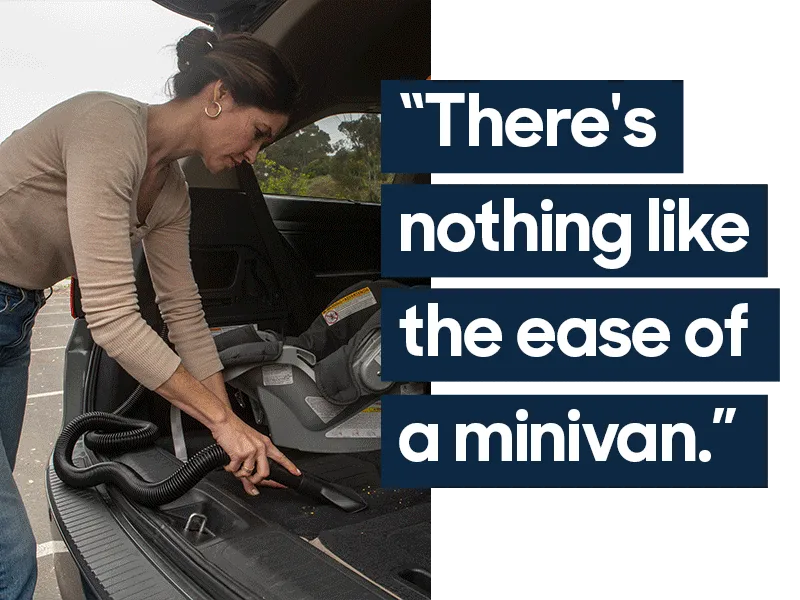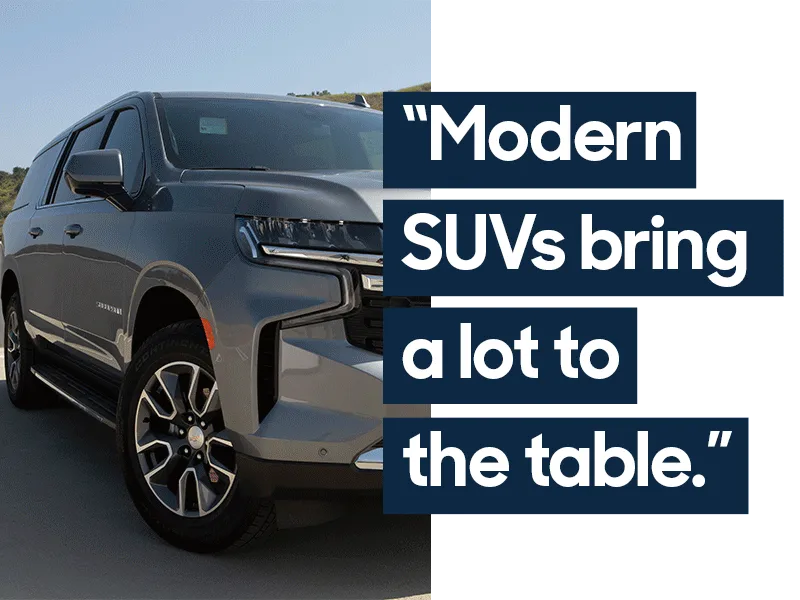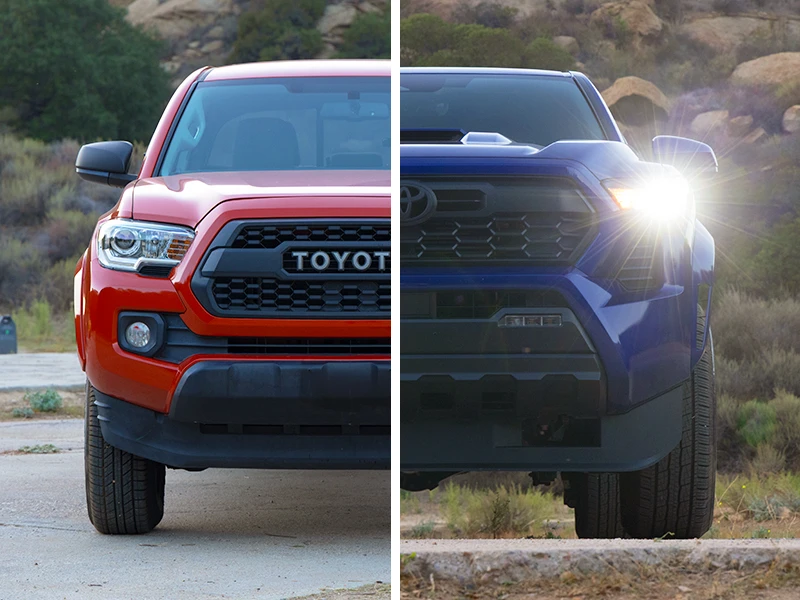
Minivans and modern SUVs offer a lot of family appeal
With thousands of vehicles in our inventory, we’re here to help make car research easier for you. We’ve partnered with car review experts from Edmunds to weigh in on what matters most when you’re looking to buy a truck or car.
***
Conventional wisdom used to be that if you have a family, especially a big family, you need a minivan. However, modern SUVs have largely caught up to minivans for offering family-friendly features and day-to-day practicality.
Let's take a look at the strengths of minivans and what SUVs bring to the table, so you can decide for yourself which used vehicle makes sense for you.
Minivan Strengths
Families, especially families with more than a couple of children in car seats, still gravitate toward minivans. Let’s see what makes them so appealing to families.

Sliding doors
The defining characteristic of minivans is also one of their biggest advantages.
When you open the sliding door on, say, a Toyota Sienna, the opening is really big, making it easy for everyone to get in and out. It's also helpful for parents with very young children. Imagine a situation where you’ve gone shopping with your infant in its car seat. You finish your shopping only to find when you return to your Sienna that someone else has parked very close to you. There’s so little room that it would be very difficult to open an SUV’s door wide enough to install the infant seat back on its base. But a minivan’s sliding doors poke out just a few inches from the body, leaving a big, wide opening for you to get your kiddo situated.
Big third row with amenities
The third row on every minivan is huge. To get third-row legroom that’s even close to what you get in a minivan, you need to look at full-size SUVs like a Chevy Suburban, and even then a minivan will typically have more third-row legroom. In addition to sheer volume, minivans also often have features such as USB charging ports in the third row. For people with several kids still in boosters and infant seats, most minivans have additional LATCH points in their third rows, expanding how many infant, toddler, and child booster seats you can use at a time.
Family-friendly features
Minivans are often where manufacturers introduce innovative family-friendly features. For example, from 2014 through 2021, the Honda Odyssey was available with a built-in vacuum cleaner on certain trims; the Chrysler Pacifica followed suit when it debuted in 2017 and continues to offer it in some trims today.
Rear-seat cameras are another perk that are hard to find outside of minivans. While convex “conversation” mirrors have been around for a while, Honda took it a step further in 2018 with its available CabinWatch® system. This system uses a camera mounted above the second row to allow the driver to see what’s going on in the back seats. Other minivans, such as the Kia Carnival, now offer similar systems on certain trims in newer model years.
Minivans are also one of the last vehicle types to have traditional rear-seat entertainment systems. Whether the screen flips down from the ceiling or is mounted on headrests, these built-in systems not only let you watch movies, but an HDMI input and 120-volt outlets can also accommodate a full-size game system.
Beyond that, you’d be hard-pressed to find an SUV with as much small-item storage, cupholders, USB ports, and other family essentials as you’ll find in a modern minivan.
Low floor
Minivans may be big, but they sit closer to the ground than most SUVs, with a lower floor. Combine that with the sliding doors, and they’re easier to get out of than SUVs, too. That goes double for little ones, who can climb in and out by themselves, and parents know how much they like to feel like “big kids.”
That lower floor also means lower seats, making it easier for parents to click infant seats into place. It’s also helpful for anybody who has mobility issues, such as grandparents, since there’s not much climb-up to get into a minivan. In the back, that low floor means it’s easy to load heavy cargo.
Cargo flexibility
There’s a crazy amount of cargo space in a minivan, especially behind the third row thanks to their deep cargo well. For example, the Chevrolet Traverse is a big midsize three-row SUV. A 2021 Traverse has 23 cubic feet of cargo space behind its third row. For comparison, the 2021 Pacifica is 40% bigger (32.3 cubic feet) and the 2021 Odyssey is 68% bigger (38.6 cubic feet)!
If you need to carry even larger loads, minivans are great at expanding their cargo capacity quickly and easily. Fold that third row into the floor and you have a big, flat load area that’s ideal for large loads. Need more space? You can typically slide the second-row seats forward for extra cargo space, or remove them entirely. A cool solution for frequent cargo carriers is the Chrysler Pacifica, which has second-row seats that actually fold into the floor. Unfortunately, the Pacifica Hybrid doesn’t have this neat trick.
SUV Strengths
Minivans definitely have family hauling locked down, and you might be thinking that there’s not much an SUV can do to compete. However, SUVs have their own strengths that might make them a better fit for you.

All-weather capability
While you can get the Toyota Sienna and Chrysler Pacifica with all-wheel drive for foul-weather driving, you won’t get the increased ground clearance and selectable drive modes that you can find in almost every modern midsize SUV. If you drive through deeper snow in the winter, or if you just want to do a little light off-roading, an SUV is the way to go.
Beyond that, some manufacturers make special models of their SUVs that increase their off-road capability. If that sounds like you, the Kia Telluride, Honda Pilot, Nissan Pathfinder, and Ford Explorer all come in off-road trims that enhance their capability without sacrificing their interior space or comfort.
Variety
That brings us to our second SUV advantage: choice. Even if you include discontinued minivans like the Nissan Quest, there are far more SUVs available to choose from. Virtually every manufacturer has something, and even if you’re picky about your desired size, performance, and features, you’ll still have more than one choice most of the time.
Engine choice
We’re not talking sheer horsepower here since minivans actually have pretty decent horsepower these days. What we mean is that in SUVs you often have more choice when it comes to how your vehicle is powered. If you just want the most power possible, there are several moderately priced SUVs that easily have more horsepower than minivans. If you want to save fuel, there are four-cylinder and hybrid options to help you conserve at the pump. On top of that, there are also some all-electric vehicles you might want to consider.
While it’s true the Toyota Sienna has been a hybrid since 2021, and the Chrysler Pacifica is available as a plug-in hybrid, there’s simply more variety when it comes to SUVs.
Towing capacity
Going hand-in-hand with extra horsepower is towing capacity. The capacity of modern minivans maxes out at around 3,500 pounds, enough for a small trailer but not much more. If you really need to tow, an SUV is going to be more capable. Most midsize SUVs have a towing capacity of 5,000 pounds, and some are even higher than that. Of course, if you need to tow really big loads, a truck is the way to go, and these days there are some fancy high-tech solutions when it comes to towing—read all about it here.
Cool factor
OK, we know this last one is subjective, but for most people, minivans are a logical and practical decision that leaves out any sort of passion. Minivans are good for you, but they’re just not very exciting, like choosing a chicken breast instead of a porterhouse steak. You can credit an SUV's off-road capability and subsequent rugged image for their higher cool factor. Sure, they’re not as practical as minivans, but they’re more fashionable, and we all know fashion comes with some compromises.
Conclusion
If you have small kids, especially if you have more than a couple still in child or infant seats, there’s nothing like the ease of use of a minivan. Those sliding doors are a godsend in tight parking spots, and there’s a seemingly endless amount of cargo room behind that third row. But as your kids grow, and the need for handy access to infant and booster seats diminishes, an SUV's appeal might get stronger.




